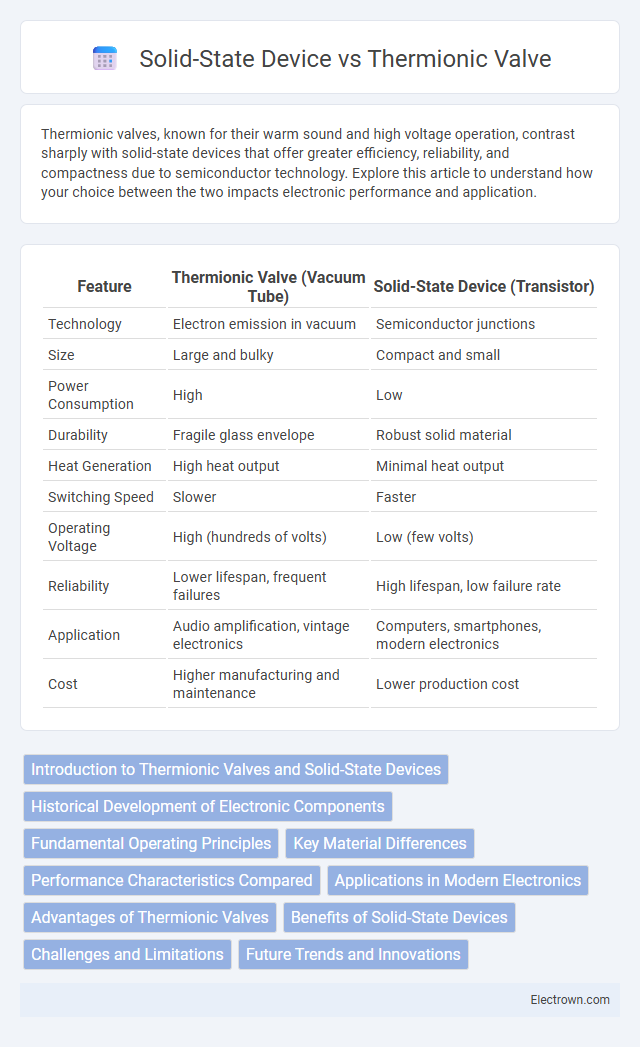Thermionic valves, known for their warm sound and high voltage operation, contrast sharply with solid-state devices that offer greater efficiency, reliability, and compactness due to semiconductor technology. Explore this article to understand how your choice between the two impacts electronic performance and application.
Table of Comparison
| Feature | Thermionic Valve (Vacuum Tube) | Solid-State Device (Transistor) |
|---|---|---|
| Technology | Electron emission in vacuum | Semiconductor junctions |
| Size | Large and bulky | Compact and small |
| Power Consumption | High | Low |
| Durability | Fragile glass envelope | Robust solid material |
| Heat Generation | High heat output | Minimal heat output |
| Switching Speed | Slower | Faster |
| Operating Voltage | High (hundreds of volts) | Low (few volts) |
| Reliability | Lower lifespan, frequent failures | High lifespan, low failure rate |
| Application | Audio amplification, vintage electronics | Computers, smartphones, modern electronics |
| Cost | Higher manufacturing and maintenance | Lower production cost |
Introduction to Thermionic Valves and Solid-State Devices
Thermionic valves, also known as vacuum tubes, operate by controlling electron flow through a vacuum between electrodes, often used in early electronics for amplification and switching. Solid-state devices rely on semiconductor materials, such as silicon, to regulate electrical current without the need for a vacuum, offering higher efficiency, smaller size, and durability. Understanding the fundamental differences in operation and material technology between thermionic valves and solid-state devices helps you choose the appropriate component for your electronic applications.
Historical Development of Electronic Components
Thermionic valves, also known as vacuum tubes, were the primary active electronic components in early 20th-century devices, enabling radio, television, and early computers through their electron flow control in a vacuum. The mid-20th century marked the rise of solid-state devices, particularly transistors invented in 1947 at Bell Labs, which revolutionized electronics by offering smaller size, greater reliability, and lower power consumption than thermionic valves. This shift from vacuum tubes to semiconductors laid the foundation for the modern electronics industry, spurring advancements in integrated circuits and microprocessors pivotal to contemporary technology.
Fundamental Operating Principles
Thermionic valves operate by controlling electron flow through a vacuum using heated cathodes and anodes, relying on thermionic emission to generate current. Solid-state devices use semiconductor materials like silicon to control electrical current via electron and hole movement within p-n junctions, enabling faster switching and greater reliability. Understanding these fundamental operating principles helps you determine the optimal technology for your specific electronic applications.
Key Material Differences
Thermionic valves rely on vacuum tubes with heated cathodes to control electron flow, using materials like tungsten or thoriated filaments and glass enclosures. Solid-state devices utilize semiconductor materials such as silicon or gallium arsenide, leveraging their electron mobility and doping properties to regulate current without needing a vacuum. Understanding these key material differences helps you appreciate performance variations, durability, and energy efficiency between the two technologies.
Performance Characteristics Compared
Thermionic valves exhibit higher power handling capabilities and superior linearity in audio amplification, but they suffer from slower response times and greater heat generation compared to solid-state devices. Solid-state devices, particularly transistors, offer faster switching speeds, enhanced reliability, and significantly lower power consumption, which make them ideal for integration in compact electronics. However, thermionic valves are still favored in high-fidelity audio applications due to their distinctive harmonic distortion and warm sound signature.
Applications in Modern Electronics
Thermionic valves, though largely replaced by solid-state devices, remain vital in specialized applications such as high-frequency radio transmitters, guitar amplifiers, and certain audio equipment due to their unique linearity and tonal qualities. Solid-state devices dominate modern electronics in computing, telecommunications, and consumer gadgets by offering greater efficiency, miniaturization, and reliability. Your choice between these technologies depends on the specific performance requirements and application environment in cutting-edge or heritage electronic systems.
Advantages of Thermionic Valves
Thermionic valves provide superior linearity and a warm, natural sound quality prized in high-fidelity audio and musical instrument amplification. Their ability to handle high voltage and power levels without distortion makes them ideal for certain specialized applications like radio frequency transmission and vintage audio equipment. You benefit from their longevity under heavy load and inherent noise immunity compared to some solid-state devices.
Benefits of Solid-State Devices
Solid-state devices offer significant advantages over thermionic valves, including greater durability, smaller size, and higher energy efficiency, making them ideal for modern electronics. Their lower heat production enhances reliability and reduces cooling requirements, which extends the lifespan of your equipment. Additionally, solid-state technology enables faster switching speeds and improved performance in compact, lightweight designs.
Challenges and Limitations
Thermionic valves face challenges such as high power consumption, large size, and vulnerability to mechanical shock, limiting their use in modern compact electronics. Solid-state devices offer improved durability and energy efficiency but encounter issues like heat dissipation and susceptibility to electrical noise in high-frequency applications. Your choice should consider these limitations depending on the specific environmental and performance requirements of your project.
Future Trends and Innovations
Thermionic valves are witnessing renewed interest through innovations in vacuum microelectronics and hybrid systems, combining their unique high-frequency and high-power capabilities with modern circuit designs. Solid-state devices continue to dominate with advancements in semiconductor materials like gallium nitride (GaN) and silicon carbide (SiC), improving efficiency, switching speed, and thermal management for applications in power electronics and RF amplification. Your choice between these technologies depends on future trends emphasizing miniaturization, energy efficiency, and the integration of novel materials to meet evolving electronic and communication demands.
Thermionic Valve vs Solid-State Device Infographic

 electrown.com
electrown.com